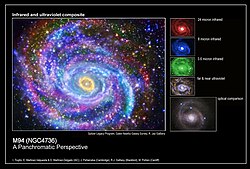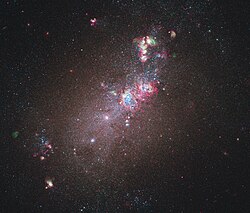Skupina Honicích psů I
| Skupina Honicích psů I | |
|---|---|
![Mapa skupiny Honicích psů I. Autor: Atlas of the Universe[1]](http://upload.wikimedia.org/wikipedia/commons/thumb/1/15/M94_group.gif/290px-M94_group.gif) Mapa skupiny Honicích psů I. Autor: Atlas of the Universe[1] | |
| Pozorovací údaje (Ekvinokcium J2000,0) | |
| Rektascenze | 13h 00m 00s[1] |
| Deklinace | +40°00′0″[1] |
| Souhvězdí | Honicí psi, Vlasy Bereniky (CVn, Com) |
| Vzdálenost | 13 M [1] ly |
| Fyzikální charakteristiky | |
| Počet galaxií | 16-24[2][3][4] |
| Nejjasnější galaxie | M94,[3] M106,[2] |
| Označení v katalozích | |
| NGC 4736 Group,[5] Canes Venatici I Group,[5] Canes Venatici Cloud,[5] LGG 291,[2] NOGG H 617,[3] NOGG P1 636,[3] NOGG P2 647[3] | |
Skupina Honicích psů I (také známá jako Skupina galaxií M 94) je volná a rozsáhlá skupina galaxií vzdálená přibližně 13 milionů světelných let[6] v souhvězdí Honicích psů a Vlasů Bereniky. Skupina tvoří spolu s dalšími blízkými skupinami Místní nadkupu galaxií (Nadkupu galaxií v Panně)[7] a je jednou ze skupin nejbližších k Místní skupině galaxií.
Ačkoli se zdá, že členové této skupiny pocházejí z jediného velkého systému, který se podobá oblaku, mnoho těchto galaxií je ke skupině gravitačně vázáno pouze slabě a některé ještě nejsou na ustálených drahách kolem středu této skupiny. Spíše se zdá, že se většina těchto galaxií pohybuje ve směru rozpínání vesmíru.[6][8]
Členové Skupiny Honicích psů I
Následující tabulka ukazuje ty členy Skupiny Honicích psů I, na kterých se shodují Nearby Galaxies Catalog,[4] Lyons Groups of Galaxies (LGG) Catalog,[2] a tři seznamy této skupiny vytvořené při průzkumu Nearby Optical Galaxies.[3]
| Název | Typ[9] | R.A. (J2000)[9] | Dec. (J2000)[9] | Rudý posuv (km/s)[9] | Magnituda[9] |
|---|---|---|---|---|---|
| IC 3687 | IAB(s)m | 12h 42m 15.1s | +38°30′12″ | 354 ± 1 | 13.7 |
| IC 4182 | SA(s)m | 13h 05m 49.5s | +37°36′18″ | 321 ± 1 | 13.0 |
| M94 | (R)SA(r)ab | 12h 50m 53.0s | +41°07′14″ | 308 ± 1 | 9.0 |
| NGC 4144 | SAB(s)cd | 12h 09m 58.6s | +46°27′26″ | 265 ± 1 | 12.1 |
| NGC 4190 | Im pec | 12h 13m 44.8s | +36°38′03″ | 228 ± 1 | 13.4 |
| NGC 4214 | IAB(s)m | 12h 15m 39.2s | +36°19′37″ | 291 ± 3 | 10.2 |
| NGC 4244 | SA(s)cd | 12h 17m 29.6s | +37°48′26″ | 244 ± 0 | 10.9 |
| NGC 4395 | SA(s)m | 12h 25m 48.9s | +33°32′48″ | 319 ± 1 | 10.6 |
| NGC 4449 | IBm | 12h 28m 11.9s | +44°05′40″ | 207 ± 4 | 10.0 |
| UGC 6817 | Im | 11h 50m 53.0s | +38°52′49″ | 242 ± 1 | 13.4 |
| UGC 7559 | IBm | 12h 27m 05.2s | +37°08′33″ | 218 ± 5 | 14.2 |
| UGC 7577 | Im | 12h 27m 40.9s | +43°29′44″ | 195 ± 0 | 12.8 |
| UGC 7698 | Im | 12h 32m 54.4s | +31°32′28″ | 331 ± 1 | 13.0 |
| UGC 8320 | IBm | 13h 14m 27.9s | +45°55′09″ | 192 ± 1 | 12.7 |
Výše uvedené zdroje často (ale neshodně) uvádějí jako členy této skupiny i NGC 4105 a UGC 8331.
Nejjasnější člen této skupiny je sporný a částečně závisí na tom, jakým způsobem se určí členové této skupiny. Katalog LGG uvádí jako člena skupiny galaxii Messier 106, která by se tak stala jejím nejjasnějším členem.[2] Ovšem ostatní katalogy Messier 106 do skupiny neřadí, a proto můžeme za nejjasnějšího člena považovat galaxii Messier 94.[3][4]
Mračno Honicích psů
Tato skupina galaxií je někdy mylně označována jako Mračno Honicích psů (Canes Venatici Cloud), což je ale větší celek, kterého je skupina pouhým členem. Mračno galaxií je částí nadkupy galaxií. Název Canes Venatici Cloud (CVn Cloud) tímto způsobem používá Tully a de Vaucouleurs.
Galerie obrázků
M94
NGC 4214
- (c) ESA/Hubble, CC BY 4.0
NGC 4244
NGC 4365
NGC 4449
NGC 4190
NGC 4144
IC 3687
Odkazy
Reference
V tomto článku byl použit překlad textu z článku M94 Group na anglické Wikipedii.
- ↑ a b c d Richard Powell. Atlas of the Universe: The Canes I Group [online]. [cit. 2016-08-12]. Dostupné online. (anglicky)
- ↑ a b c d e A. Garcia. General study of group membership. II - Determination of nearby groups. S. 47–90. Astronomy and Astrophysics Supplement [online]. Červenec 1993 [cit. 2016-08-12]. Roč. 100, s. 47–90. Dostupné online. Bibcode 1993A&AS..100...47G. (anglicky)
- ↑ a b c d e f g G. Giuricin; C. Marinoni; L. Ceriani, et al. Nearby Optical Galaxies: Selection of the Sample and Identification of Groups. S. 178–194. Astrophysical Journal [online]. Listopad 2000 [cit. 2016-08-12]. Roč. 543, čís. 1, s. 178–194. Dostupné online. arXiv astro-ph/0001140. DOI 10.1086/317070. Bibcode 2000ApJ...543..178G. (anglicky)
- ↑ a b c R. B. Tully. Nearby Galaxies Catalog. Cambridge: Cambridge University Press, 1988. ISBN 0-521-35299-1.
- ↑ a b c SIMBAD Astronomical Database: Results for NGC 4736 Group [online]. [cit. 2016-08-12]. Dostupné online. (anglicky)
- ↑ a b I. D. Karachentsev. The Local Group and Other Neighboring Galaxy Groups. S. 178–188. Astronomical Journal [online]. Leden 2005 [cit. 2016-08-12]. Roč. 129, čís. 1, s. 178–188. Dostupné online. arXiv astro-ph/0410065. DOI 10.1086/426368. Bibcode 2005AJ....129..178K. (anglicky)
- ↑ R. B. Tully. The Local Supercluster. S. 389–422. Astrophysical Journal [online]. Červen1982 [cit. 2016-08-12]. Roč. 257, s. 389–422. Dostupné online. DOI 10.1086/159999. Bibcode 1982ApJ...257..389T. (anglicky)
- ↑ ; M. E. Sharina; A. E. Dolphin, et al. Galaxy flow in the Canes Venatici I cloud. S. 467–477. Astronomy and Astrophysics [online]. Únor 2003 [cit. 2016-08-12]. Roč. 398, čís. 2, s. 467–477. Dostupné online. arXiv astro-ph/0210414. DOI 10.1051/0004-6361:20021598. Bibcode 2003A&A...398..467K. (anglicky)
- ↑ a b c d e NASA/IPAC Extragalactic Database: Results for Various Galaxies [online]. [cit. 2016-08-12]. Dostupné online. (anglicky)
Související články
- Skupina galaxií v Sochaři – další blízká skupina galaxií se slabou gravitační vazbou
Externí odkazy
 Obrázky, zvuky či videa k tématu Skupina Honicích psů I na Wikimedia Commons
Obrázky, zvuky či videa k tématu Skupina Honicích psů I na Wikimedia Commons - Skupina galaxií M94 @ SEDS
Média použitá na této stránce
Galaxy NGC 4214, pictured here in an image from the NASA/ESA Hubble Space Telescope’s newest camera, is an ideal location to study star formation and evolution. Dominating much of the galaxy is a huge glowing cloud of hydrogen gas in which new stars are being born. A heart-shaped hollow — possibly galaxy NGC 4214’s most eye-catching feature — can be seen at the centre of this. Inside this cavity lies a large cluster of massive, young stars ranging in temperature from 10 000 to 50 000 degrees Celsius. Their strong stellar winds are responsible for the creation of this bubble. These features have the effect of stemming any further star formation due to the subsequent lack of gas.
(c) ESA/Hubble, CC BY 4.0
A silver needle in the sky
This stunning new image from the NASA/ESA Hubble Space Telescope shows part of the sky in the constellation of Canes Venatici (The Hunting Dogs).
Although this region of the sky is not home to any stellar heavyweights, being mostly filled with stars of average brightness, it does contain five Messier objects and numerous intriguing galaxies — including NGC 5195, a small barred spiral galaxy considered to be one of the most beautiful galaxies visible, and its nearby interacting partner the Whirlpool Galaxy (heic0506a). The quirky Sunflower Galaxy is another notable galaxy in this constellation, and is one of the largest and brightest edge-on galaxies in our skies.
Joining this host of characters is spiral galaxy NGC 4244, nicknamed the Silver Needle Galaxy, shown here in a new image from Hubble. This galaxy spans some 65 000 light-years and lies around 13.5 million light-years away. It appears as a wafer-thin streak across the sky, with its loosely wound spiral arms hidden from view as we observe the galaxy side on. It is part of a group of galaxies known as the M94 Group [1].
Numerous bright clumps of gas can be seen scattered across its length, along with dark dust lanes surrounding the galaxy’s core. NGC 4244 also has a bright star cluster at its centre. Although we can make out the galaxy’s bright central region and star-spattered arms, we cannot see any more intricate structure due to the galaxy’s position; from Earth, we see it stretched out as a flattened streak across the sky.
A number of different observations were pieced together to form this mosaic, and gaps in Hubble’s coverage have been filled in using ground-based data. The Hubble observations were taken as part of the GHOSTS survey, which is scanning nearby galaxies to explore how they and their stars formed to get a more complete view of the history of the Universe. Notes
[1] Our home group, containing the Milky Way and many others, is known as the Local Group. M94 is relatively close to the Local Group.
Credit:
NASA & ESA Acknowledgement: Roelof de Jong
About the Object
Name: NGC 4244
Type: • Local Universe : Galaxy : Type : Spiral
• X - Galaxies Images/Videos
Distance: 130 million light years
Colours & filters Band Wavelength Telescope Infrared I 814 nm Hubble Space Telescope ACS Optical V 606 nm Hubble Space Telescope ACS.
Autor: R. Jay GaBany, Spitzer Legacy Program, GALEX Nearby Galaxy Survey, Licence: CC BY-SA 3.0
In the October 10, 2009 edition of the Astrophysical Journal, an international team of astrophysicists and astronomers have reported that the outer ring surrounding M94 (NGC4736) is not a closed stellar ring, as historically reported in the literature, but an extensive structure featuring spiral arms and energetic new star formation.
Irregular Galaxies IC 3687
Autor: Own work, Licence: CC BY-SA 3.0
Color rendering is done by by Aladin-software (2000A&AS..143...33B.)
Autor: Credit Line and Copyright Adam Block/Mount Lemmon SkyCenter/University of Arizona, Licence: CC BY-SA 3.0 us
NGC 4395
Picture Details:
Optics 32-inch Schulman Telescope (RC Optical Systems) Camera SBIG STX 16803 CCD Camera Filters AstroDon Gen II Dates April-May 2014 Location Mount Lemmon SkyCenter Exposure LRGB = 12:3:3.5:3.5 Hours Acquisition ACP Observatory Control Software (DC-3 Dreams), Maxim DL/CCD (Cyanogen), FlatMan XL (Alnitak) Processing CCDStack (CCDWare), Photoshop CC (Adobe), PixInsight Credit Line and Copyright Adam Block/Mount Lemmon SkyCenter/University of Arizona.
Autor: Own work, Licence: CC BY-SA 3.0
Color rendering is done by by Aladin-software (2000A&AS..143...33B.)
Hình ảnh thiên hà vô định hình NGC 4449 quan sát bởi kính viễn vọng không gian Hubble. Ảnh: ASA, ESA, A. Aloisi (STScI/ESA) và The Hubble Heritage (STScI/AURA)-ESA/Hubble Collaboration
















